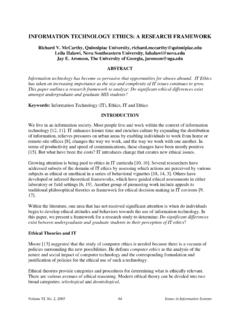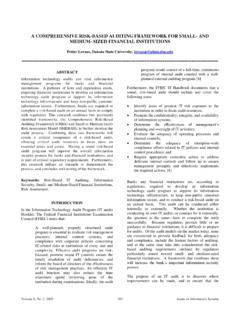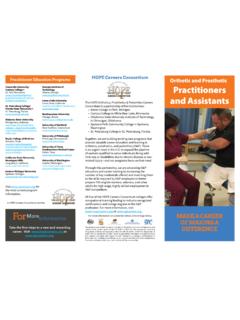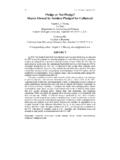Transcription of A COMPARISON OF ENTERPRISE ARCHITECTURE …
1 Volume VII, No. 2, 2006 18 Issues in Information Systems A COMPARISON OF ENTERPRISE ARCHITECTURE FRAMEWORKS Lise Urbaczewski, Eastern Michigan University, Stevan Mrdalj, Eastern Michigan University, ABSTRACT An ENTERPRISE ARCHITECTURE framework (EAF) maps all of the software development processes within the ENTERPRISE and how they relate and interact to fulfill the ENTERPRISE s mission. It provides organizations with the ability to understand and analyze weaknesses or inconsistencies to be identified and addressed. There are a number of already established EAF in use today; some of these frameworks were developed for very specific areas, whereas others have broader functionality.
2 This study provides a COMPARISON of several frameworks that can then be used for guidance in the selection of an EAF that meets the needed criteria. Keywords: ARCHITECTURE Frameworks, ENTERPRISE ARCHITECTURE , COMPARISON INTRODUCTION ENTERPRISE ARCHITECTURE serves as the blueprint for the system and the project that develops it. An ENTERPRISE ARCHITECTURE framework can describe the underlying infrastructure, thus providing the groundwork for the hardware, software, and networks to work together. According to the Systems & Software Consortium [11], An ENTERPRISE ARCHITECTURE relates organizational mission, goals, and objectives to work processes and to the technical or IT infrastructure required to execute them.
3 In addition, a good ARCHITECTURE and its corresponding documentation allow for ease of maintenance in order that the system does not become obsolete before it is even built. There are a number of architectures and architectural frameworks in use today. Though they may overlap or address similar views, frameworks also have been designed to address specific needs or concerns. These frameworks differ by the stakeholders they address and the issues that concern their *world*. These issues or building blocks represent methods, common vocabulary, standards [13], and tools that provide a means to implement and integrate the building blocks.
4 In addition, government, commercial, and sub-categories of each of these may require certain protocols to follow. Goethals [6] and Schekkerman [8] provide comprehensive overviews of EAF in the literature. Informal comparisons between specific architectures have also been made [7]. The Open Group [12] has drawn comparisons between its architectural framework , TOGAF, and existing frameworks. Tang et. al provide an analysis of frameworks at a high level, based on their goals, inputs and outcomes [10]. The aim of this paper is to provide a direct COMPARISON of the frameworks, based on their views and aspects.
5 In order to establish a common ground for the framework COMPARISON , we studied several existing ENTERPRISE ARCHITECTURE frameworks. Second, we created a method to compare the frameworks based on the perspectives of their stakeholders and abstractions. Third, we then compared the frameworks. From this, we discuss the ways that such comparisons can be used in determining a best-fit of a framework dependent on specific stakeholder needs for a given project. OVERVIEW OF EXISTING ENTERPRISE ARCHITECTURE FRAMEWORKS The following are concise descriptions of five EAFs that are used in this COMPARISON . Zachman framework for ENTERPRISE ARCHITECTURE : John Zachman published the Zachman framework for ENTERPRISE ARCHITECTURE in 1987 [14] and is considered to be one of the pioneers in this domain [6].
6 According to Zachman [15], the increased scope of design and levels of complexity of information systems implementations are forcing the use of some logical construct (or ARCHITECTURE ). The Zachman framework is based around the principles of classical ARCHITECTURE that establish a common vocabulary and set of perspectives for describing complex ENTERPRISE systems. The Zachman framework has six perspectives or views: Planner, Owner, Designer, Builder, Subcontractor, and User. The second dimension of Zachman s framework deals with the six basic questions: what, how, where, who, when and why [6]. The framework does not provide guidance on sequence, process, or implementation, but rather focuses on ensuring that all views are well established, ensuring a complete system regardless of the order in which they were established.
7 The Zachman framework has no explicit compliance rules since it is not a standard written by or for a professional organization. However, A COMPARISON of ENTERPRISE ARCHITECTURE Frameworks Volume VII, No. 2, 2006 19 Issues in Information Systems compliance can be assumed if it is used in its entirety and all the relationship rules are followed [9]. Department of Defense ARCHITECTURE framework (DoDAF): The Department of Defense ARCHITECTURE framework (DoDAF) [2] builds on three sets of views : Operational, System, and Technical Standards. A fourth view, All View, augments the other views by providing the linkage between the views by means of a dictionary to define terms and by providing context, summary, or overview-level information [3].
8 This framework provides descriptions of final products as well as guidance and rules for consistency. This ensures a common denominator for comparing, and integrating Families of Systems, Systems of Systems, and interoperating and interacting architectures [2]. Federal ENTERPRISE ARCHITECTURE framework (FEAF): The Federal ENTERPRISE ARCHITECTURE framework was developed and published by the US Federal Chief Information Officers (CIO) Council [5]. Government was following the industry trend of defining architectural frameworks to guide in the development of large, complex systems development. FEAF was in response to the Clinger-Cohen Act, 1996 [1], which required Federal Agency CIOs to develop, maintain, and facilitate integrated systems architectures.
9 The overriding goal of FEAF is to organize and promote sharing of Federal information for the entire Federal Government [6]. The architectural segments are developed individually, within structured guidelines, with each segment considered to be its own ENTERPRISE within the Federal ENTERPRISE . We include the Federal ENTERPRISE ARCHITECTURE (FEA) - Practical Guide [4] within our discussion on FEAF because it provides the guidance to federal agencies for frameworks. FEA allows for flexibility in the use of methods, work products, and tools to be used by the individual federal agencies. Treasury ENTERPRISE ARCHITECTURE framework (TEAF): The Department of the Treasury published the Treasury ENTERPRISE ARCHITECTURE framework (TEAF) in July 2000.
10 The Department of the Treasury is comprised of a number of offices that function as individual enterprises. Therefore, its ENTERPRISE ARCHITECTURE needs to map the interrelationships among the organizations in order to manage IT resources. The TEAF aims at facilitating integration, information sharing, and exploitation of common requirements across the department [6]. Similar to DoDAF, TEAF includes descriptions of work products for documenting and modeling ENTERPRISE architectures. TEAF also explicitly states that these work products align with FEAF models and DoDAF products [6]. The Open Group Architectural framework (TOGAF): The Open Group Architectural framework (TOGAF) was first developed in 1995 and was based on the Department of Defense s Technical ARCHITECTURE framework for Information Management [12].







